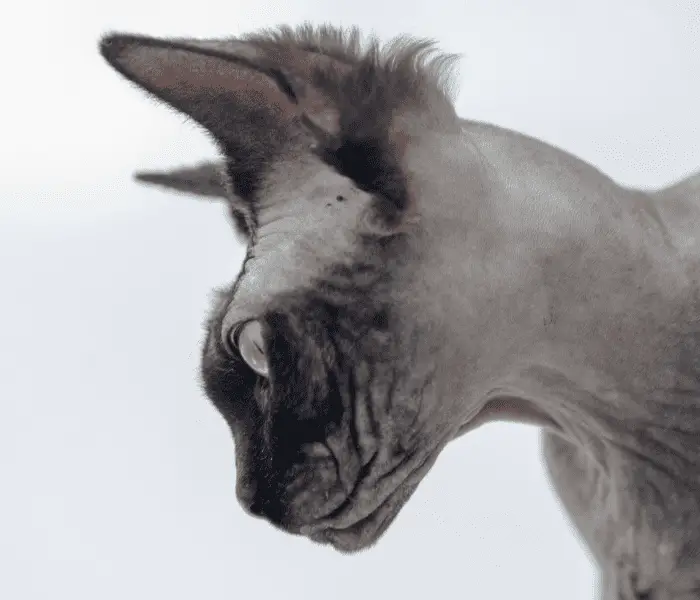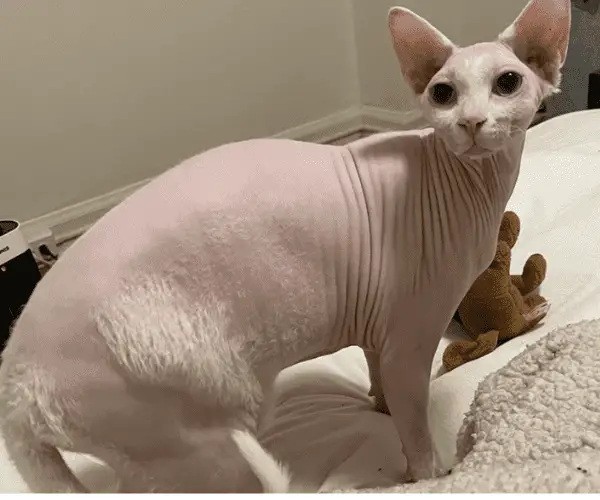
Sphynx cats are known for their short hair coats and loveable, energetic personalities. They come in various colors and patterns and range from being entirely bald to having some “peach fluff” over their body. They boast a very fine, short coat of fuzz which gives their skin the feeling of suede, with their pattern variation being due to differences in the pigmentation of their skin. They also often lack whiskers and other tactile hairs.
Sphynx cats are hardy breeds with high grooming requirements and suffer from few health problems. They are active cats and, despite their short coats, are not hypoallergenic due to the production of allergenic dander from their skin. They have oily skin which needs to be cleaned regularly and protected from sunburn, skin damage, and cold temperatures.
Sometimes sphynx cats grow patches of hair around their body. This usually occurs in the winter months but may also occur due to hormonal changes in intact males and females or if it is a mixed breed sphynx cat. To understand why this happens, it is important first to consider the types of hair that cats have and the genetic reasons behind the hairless nature of this breed.
Hair Types In Cats
Most cats have four types of hair:
- Down hair: this hair acts as an insulating undercoat and is a silky soft layer that helps to prevent heat loss in cold weather.
- Awn hair: this hair helps to protect the down hairs and acts as insulation. These are the most visible hairs and are typically coarse with dark tips.
- Guard hair: these hairs give the cat’s coat its color and are made up of long, coarse hairs that also provide a waterproof layer to stop water from reaching the undercoat.
- Whiskers (also known as vibrissae): these sensory hairs help give the cat a sense of the space around them and are found on their cheeks, muzzle, above their eyes, and edges of their legs
Sphynx cats, however, lack these hairs and instead have a different kind of hair called vellus. Vellus is a very fine, thin hair that covers their body much like how it covers our own skin. These hairs are what is responsible for the soft feeling that is noticeable when stroking a sphynx cat.
Sphynx cats lack the ‘normal’ hair types furry cats have and instead have vellus hairs, which is a very fine hair that covers much of their body.
Genetics and Dermatology
Sphynx cats contain a hairless allele in their genes. This allele represents a mutation in the gene that codes for keratin (KRT71 gene). Keratin is a protein that is found in the inner root sheath of all hair follicles. In sphynx cats, this protein does not function, which means that the hair follicle is usually tiny, curved, and kinked and cannot hold the hair in place as it should, with the hairs often becoming dislodged. Hair shafts are also often smaller in diameter and misshapen.
The KRT71 gene also affects other breeds like the Devon Rex cat and Hereford cattle. In this breed, the KRT71 gene is active but has minimal functionality. This explains why they do not have as much hair as other cats but still have more hair than sphynx cats. The KRT71 gene in these breeds also encodes for curly fur, a notable characteristic of these and other breeds.
The KRT71 gene is a recessive gene, meaning that for a sphynx cat to be hairless, it needs to have both recessive alleles (ss) and no dominant allele (SS or Ss). If the cat has just one (or even both) dominant allele in the pair, it will not be hairless and may have patches of hair growing around its body. If the dominant allele exists in either of the parent cats, it may be passed to the kitten, causing the kitten to develop a furry coat. For a purebred, hairless sphynx to be born, both parents must have only the recessive alleles.
Since two hairless parent sphynx cats (with the recessive ‘ss’ alleles) must be crossed to produce kittens without hair, if one hairless parent (ss) is crossed with any other cat that contains hair (SS or Ss), the kitten may have characteristics that are like sphynx cats but may also have hair. Therefore, due to these genetic reasons, if your sphynx cat has hair from the time it is born, it is likely not a purebred cat and is instead a mixed breed.
Pet Vet Tip: For more information on sphynx cats genetic, have a look at the article explaining wether a sphynx cat can give birth to kittens with fur.
Reasons For Hair Growth in Sphynx Cats
1. Genetics
As already stipulated above, one reason for your sphynx cat to have hair is that it is, in fact, carrying genes from another breed. Another possibexplanationson is that the ‘sphynx’ cat has been confused with another cat breed that looks very similar to it; the Donskoy cat (also known as a Russian hairless or Don sphynx cat).
Unlike the true sphynx cat, the Donskoy cat has their hairless trait due to a dominant mutation, meaning they can be born with hair. They have four different coat types ranging from complete hairlessness to velvety or woolly hair, which they may progressively lose as they age. Despite losing some of their hair, they may retain shorter strands on their face, tail, and legs.
Other hairless breeds include the bambino, Peterbald, Ukrainian levkoy, elf, dwelf, and minskin breeds.
| Sphynx Cat | ||
| Donskoy Cat | Not related to the sphynx cat | |
| Minskin Cat | Sphynx crossed with a munchkin with the addition of genes from Devon Rex and Burmese cats | |
| Bambino Cat | Sphynx crossed with a munchkin | |
| Peterbald Cat | Donskoy crossed with an oriental shorthair | |
| Ukrainian Lekvoy Cat | Donskoy crossed with a Scottish fold | |
| Elf Cat | Sphynx crossed with an American curl | |
| Dwelf Cat | Sphynx crossed with a munchkin and American curl | |
| *All images are courtesy of Getty Images |
2. Colder Weather
Another common reason your sphynx cat may grow hair is due to a change in weather, specifically the onset of cold weather during winter. This change may occur at any time and in any sphynx cat but commonly occurs to prepare them for the cooler months. This is a natural response by the body to maintain normal body temperature despite the changes occurring in ambient temperatures.
The fuzzy coat that they may develop usually starts to shed once the cold weather dissipates, and summer starts to roll around. This is because the body no longer needs additional protection from the cold elements.

(D_Eliana, 2021)
One way to prevent the production of hair during this time is to ensure a constant source of warmth for your sphynx cat. This may take the form of heaters, warm water bottles, or a cat sweater or scarf, which may be purchased from pet stores, or online, or you could knit your own.
Remember that not all sphynx cats may tolerate wearing this type of clothing. An alternative solution is to create a warm space with fleece blankets and cat caves that they can utilize as they need. This space also provides a safe haven for them and may help to reduce stress.
3. Hormonal Changes
Hair growth in sphynx cats has also been linked to hormonal changes that are common in intact males and females. The skin is receptive to a variety of hormones, including sex hormones. The exact link between sterilization and hair growth is not particularly clear; however, there does seem to be a link between these hormones and hair growth in sphynx cats that have not been spayed or neutered.
In humans, it has been shown that androgens (such as testosterone) act on sex-specific areas of the body and convert fine vellus hairs (the same hairs found on sphynx cats) into terminal hairs that are larger and darker. This information has been extrapolated to sphynx cats to try and explain the phenomenon of hair growth in intact males and females.
One way to prevent hair growth from hormonal changes is to spay or neuter your sphynx cat. This helps reduce estrogen and testosterone’s influence on hair growth. Sterilization is also beneficial as it prevents unwanted pregnancies, reduces aggression between cats, reduces the urge to roam, reduces the need to spray and mark their territory, and reduces the risk of various cancers.
Conclusion
There are a few reasons your sphynx may have hair, which vary from genetics to hormones to seasonal changes. However, the presence of hair does not mean that your sphynx cat has underlying health issues, nor does it mean that it needs less attention and care than the hairless sphynx cat.
If your sphynx cat was born with hair, then it is likely a mixed breed, and nothing can be done to inhibit the hair growth; however, it is possible to inhibit the growth of hair that is not congenitally present through spaying or neutering your sphynx cat as well as making sure that it does not become cold (especially during winter).
Remember, under no circumstances should you shave your hairy sphynx cat. The hair should shed naturally once the factors causing the hair growth are removed. Shaving your sphynx may also damage their sensitive skin.
If you find yourself in a predicament where your sphynx cat has suddenly adorned itself with a fur coat, do not panic. Consider the reasons above and try and rectify these. If the hair growth persists, or the factors for natural hair growth are not present, then it is advisable to contact your veterinarian, who may advise bringing your now furry companion in for a check-up.
References
- Genovese, D. W., T. L. Johnson, K. E. Lamb and W. D. Gram (2014). “Histological and dermatoscopic description of sphynx cat skin.” Veterinary Dermatology 25(6): 523-U558.
- Gandolfi, B., C. A. Outerbridge, L. G. Beresford, J. A. Myers, M. Pimentel, H. Alhaddad, J. C. Grahn, R. A. Grahn and L. A. Lyons (2010). “The naked truth: Sphynx and Devon Rex cat breed mutations in KRT71.” Mammalian Genome 21(9-10): 509-515.
- Grymowicz, M., E. Rudnicka, A. Podfigurna, P. Napierala, R. Smolarczyk, K. Smolarczyk and B. Meczekalski (2020). “Hormonal Effects on Hair Follicles.” Int J Mol Sci 21(15).
- Spanner, H. (2022) Why are sphynx cats hairless?, BBC Science Focus Magazine. BBC Science Focus Magazine.

